Alan Soffer: Painting Survey & Dennis Beach: Painting and Sculpture
Since the late 1980s, Wilmington’s Blue Streak Gallery has presented two highlights of regional art. As I entered recently, the first leaped to colorful life in an array of patterns and textures, as an abundance of hand-made contemporary crafts from jewelry to clothing to ceramics lined the walls and beckoned from display cases. My eye moved, blue-streak-like, around the room to take it all in. A walk through this kaleidoscope brought me around a corner to the gallery’s second focus—a place with a different mood. Here, where individual artists display their work against almost-white walls, my eyes slowed down to absorb the current exhibition featuring work by Dennis Beach and Alan Soffer. On the two main walls, Beach’s hard-edge geometric abstraction and Soffer’s abstract expressionism face each other in what seems at first like a classic confrontation of opposites. In several turns around the gallery, though, I began to see and feel affinities.
Tall, columnar, and vividly colored, Beach’s Spin #6LC (IMAGE 1) commands attention.
1.
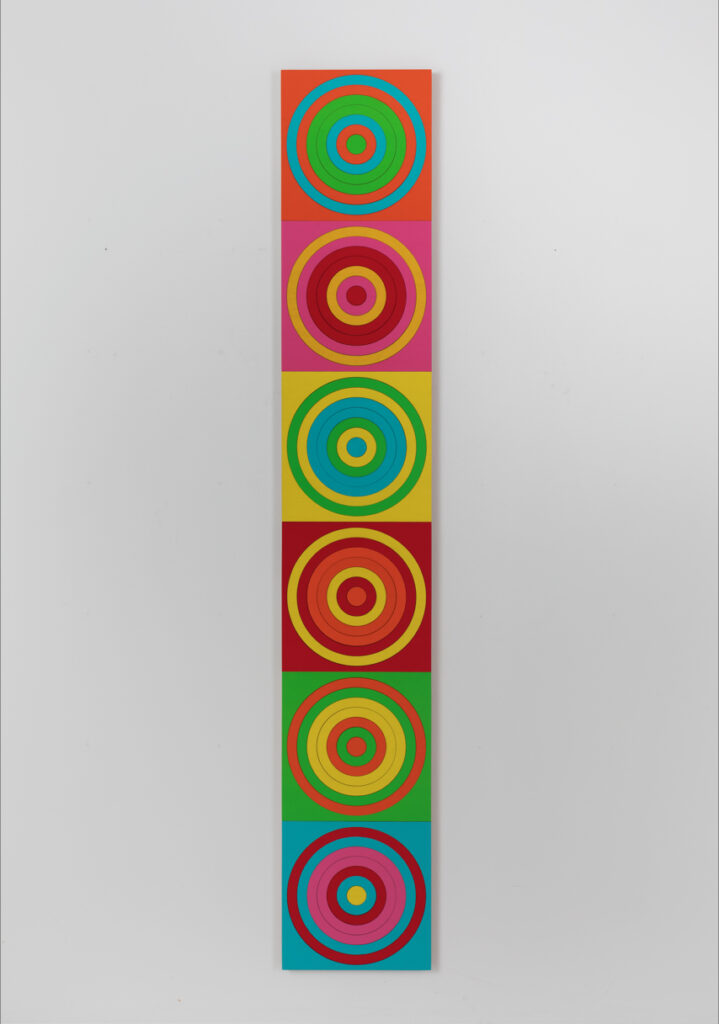
Dennis Beach, Spin #6LC, acrylic on plywood, 81 x 13.5 inches, 2019
Crisply-defined rings orbiting their centers are set against an equally multi-colored stack of squares. The energetic hues ebb and surge. While the spinning shapes do call to mind Duchamp’s Coeur Volant and the illusions of Op Art, the overall effect is more one of solidity. Forms seem steady and self-contained, fulfilled in their boundaries. Mesmerized by trying to spot a pattern of color relationships in the lively design, I found predictability pleasingly elusive. Freedom coexists with order. Call it playful structure. Longer analysis might have led to a more precise calculation but my wandering eyes enjoyed the moments of visual discovery.
The glow of a more limited palette of colored acrylic elements in Spin #A-1 (IMAGE 2) intensifies an appearance of rotation.
2.
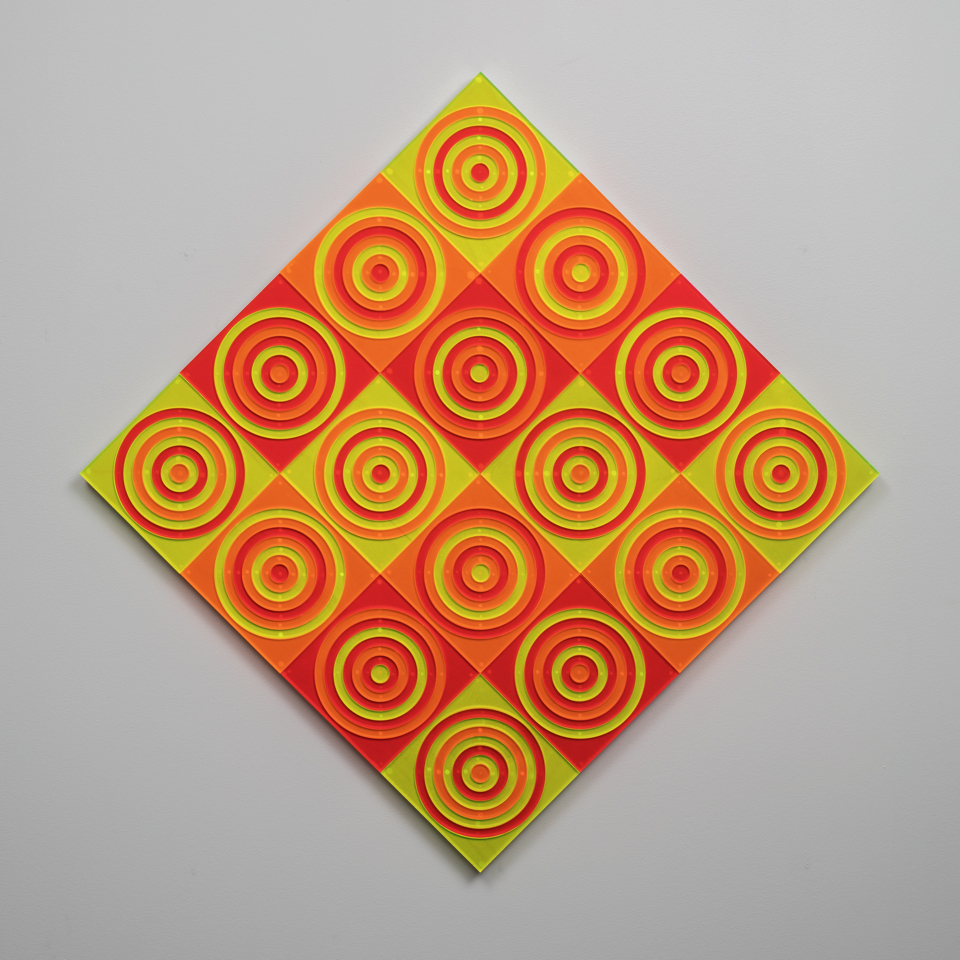
Dennis Beach, Spin #A-1, colored acrylic on plywood, 21.5 x 21.5 inches, 2019
A square-turned-diamond shape creates a sense of tension, as if the piece lives in exquisite and radiant balance on a point. The whole impression is—again—one of opposites: agile movement and calm stasis. Beach’s early studies included engineering, and it’s not surprising that Ellsworth Kelly’s minimalist works caught his attention.
Beach has spoken about how his repeated elements allude to the wealth of such forms in nature. In leaves, sand dunes, and crystals, on tortoise shells and snakeskins, even in our own bilateral symmetry—the geometry and color of nature are boundless. Pondered by philosophers and scientists for ages, such patterns may be ephemeral or long-lasting. They grow in nature; they may take shape in the mind, and then in the hands, of an artist.
Beach’s hands are present in his mastery of the materials that bring his imaginative concepts to prismatic reality. In Spin #6LC, the grain of the plywood emerges from the smooth brushwork over the squares. In Spin #A-1, there is a precisely-placed series of white dots in each square; these are the bits of glue holding the rings to the board.
I imagine the artist in his studio engaged with paint and brushes, along with laser cutter and computer-controlled router. Traditional and contemporary methods invigorate each other. And in Beach’s work’s, reassuring stability complements a sprightly mood.
Turning to Alan Soffer’s wall I felt as if I’d entered another world. In fact, that’s almost the title of one of his paintings: A World Apart II. (IMAGE 3).
3.
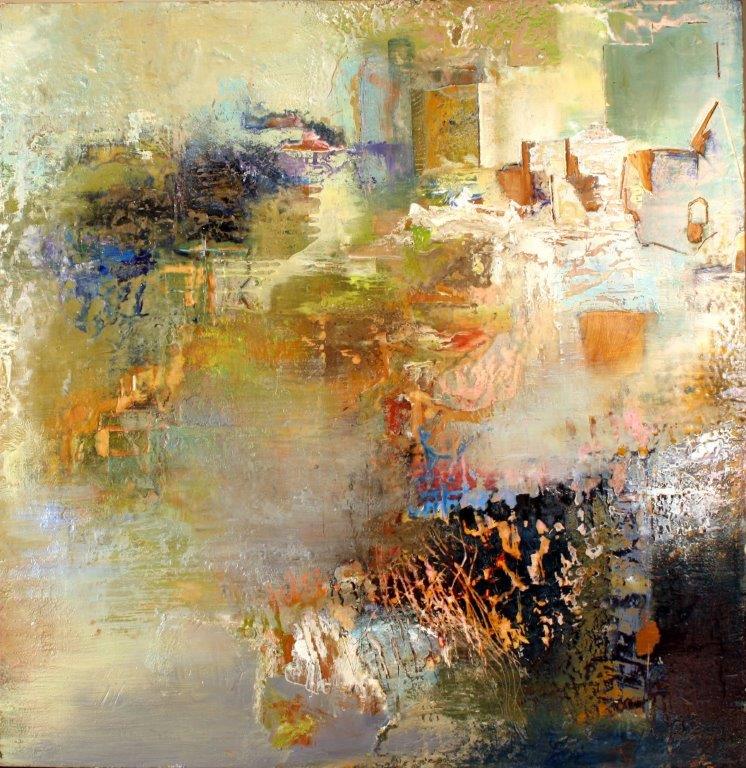
Alan Soffer, A World Apart II, 31 x 31 inches, encaustic and oil on board, not dated
Its colors merge, drip, and break through each other in sweeping masses and tiny points, transcending the well-worn adjective “gestural.” Some colors drifted toward or away from me, though they seemed to breathe rather than move. Somber deep blues float along with colors that call up oceans and gardens. Pale diaphanous shades fuse with dark shadowy ones. My ever-rational eye wanted to detect shapes, even fleetingly seeing (maybe) a castle rising in the upper right. But all boundaries dissolved, leaving me immersed not in chaos but in a luminous universe, wondering just where I was. Soffer has said, “I have built a lifelong practice of letting my unconscious rule the day’s work.” A World Apart II set my mind and eyes free to experience a place untethered by material reality.
In White Microcosm, Soffer’s title tells us that we are seeing a small version of the universe.
4.
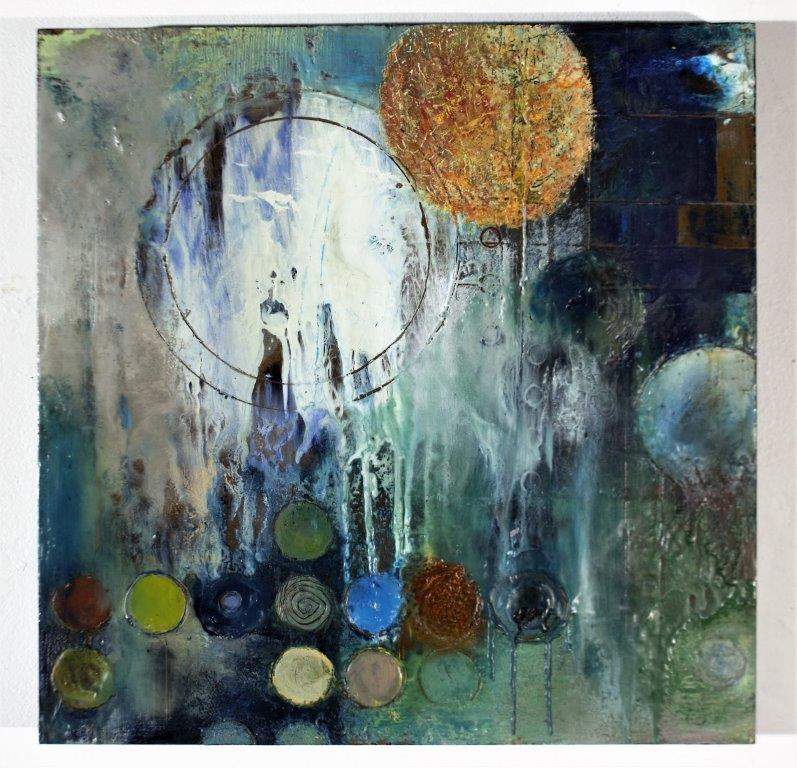
Alan Soffer, White Microcosm, encaustic on board, 16 x 16 inches, not dated
Armed with that title, I felt like a visitor from the 17th century, enchanted with my newly-discovered microscope and telescope. I detected infinitesimal wriggling organic forms in a ball and a moon-like disc hovering among other interplanetary orbs. Deeply receding space, rippling paint, and a shard of brilliant light suggest not just terrestrial life forms and distant galaxies, but the boundless worlds of astronomy, botany, and geology. And intimations of pictograph-like forms hint at the presence of humanity. This literal view is not of course what Plato (or probably Soffer) had in mind when thinking about the microcosm-macrocosm correspondence. The microcosm reflects the metaphysical universe, and this spirit—intangible by nature—suffuses Soffer’s sensuous painting.
Envisioning Soffer in his studio calls up the challenges and rewards of the ancient technique of heated wax and pigment. In his hands, encaustic’s malleability and translucence make a painting weighty, or buoyant, or many states in between on the same canvas. His work invites us to risk discovering the turmoil or delight of unexplored vistas.
I began to see the compatibility of the Beach-Soffer pairing. The artists’ differences harbor a convergence. Whether planned with mathematical precision or guided by the unconscious, both marry the vastness of the physical universe with the endlessness of the imagination.
For more about Dennis Beach and Alan Soffer, see:
http://www.dennisbeach.tv/project-2
http://schmidtdean.com/?page_id=113
https://www.alansofferart.com/home
https://artworkshopvacations.com/OLD/facilitator_Alan%20Soffer%20andLibbie%20Soffer.php
Blue Streak Gallery is located at 1721-1723 Delaware Ave, Wilmington, DE 19806. (302) 429-0506. Open:

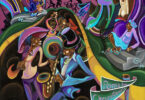
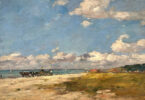
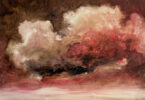

Leave a Comment